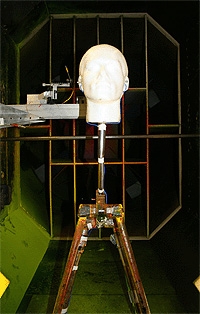The vast majority of noise that motorcyclists experience doesn’t emanate from the engine or other vehicles, but rather from air flow around the bike, helmet and body.
‘As a rule of thumb, if you do 70mph [113km/h], it takes about 15 minutes to hit your daily noise dose,’ project lead Michael Carley, a mechanical engineer at Bath University, told The Engineer.

‘Obviously there’s a workplace health and safety problem here, and that’s why the first people who started worrying about this were the employers of professional riders, because they were, in principle, laying themselves open to litigation for hearing damage through negligence,’ he added.
Indeed, police riders must now have annual hearing assessments; however, little research has been performed out of house for the direct benefit of consumers.
Carley’s team first performed measurements on volunteer motorcyclists who were equipped with a basic GPS device and microphone — allowing them to plot road speed against noise at each point of the audio recording. This revealed a linear scale peaking at 115dB at around 80mph.
After that, they booked time at a race track, where they were able to film motorcyclists, again carrying microphones, but this time relating noise to various rider positions.
Data gathered in the field were then used for controlled experiments in a wind tunnel, with some interesting findings.
First, the windshield seemed to create turbulent air flow and buffeting around the head, which showed considerable variation in noise levels depending on the position of the rider. But, surprisingly, one of the largest sources of noise came from air rushing around the chin cavity of the helmet.
‘We hadn’t expected it was quite as big a contributor to the noise as it was. We suspect it’s similar to the aerodynamics of landing-gear cavities on aircraft, which are responsible for a fair bit of noise when they are coming into land,’ Carley said.
Finally, another type of noise experienced by motorcyclists that is more difficult to measure is body-conducted sound — where the percussive force of the wind on slapping against the rider is conducted through the flesh and bone.
‘The first thing you do when you protect again noise is wear earplugs — something every rider should do — but it only protects to a certain point because you get noise transmitted through the body… basically direct to your eardrum.’
Teamwork
The efforts of Carley’s team coincided with work being done by psychologists at Bath Spa University on the effect that heat and carbon dioxide (from exhaling) within the helmet have on cognitive responses. The groups therefore got together to investigate how noise might affect riders’ concentration and how they perceive hazards. Early results suggest that noise may actually have a negative influence on riders’ peripheral vision.
Having now gathered a substantial body of evidence characterising noise, Carley’s team is exploring a number of options to mitigate the problem, starting with well-informed advice on riding position and bike setup for motorcyclists.
Meanwhile, from a technology standpoint, the team is investigating noise cancelling, vibration dampening and the use of acoustically absorbent materials for helmets.
But Carley admits that helmet design will be a tricky thing to tackle in terms of noise reduction, since the main priorities for manufacturers are, understandably, impact protection and comfort. A different tactic may be to encourage, or impel, manufacturers to adopt noise ratings on their products.
‘There’s probably too much variation between people’s heads to be able to say this is the absolute noise level of this helmet — you wouldn’t be able to fix a legal noise limit,’ he said. ‘But you should be able to have something such as those energy [-efficiency] stickers you have on your fridge or washing machine, where [for example] it’s an A-, B-, C- or D-rated helmet for noise.’





Project to investigate hybrid approach to titanium manufacturing
What is this a hybrid of? Superplastic forming tends to be performed slowly as otherwise the behaviour is the hot creep that typifies hot...